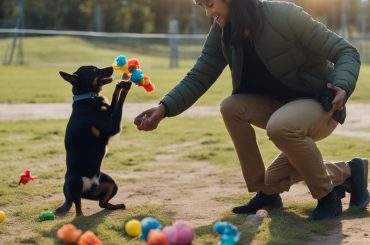Teaching your dog to sit is an essential command that can benefit both their safety and your daily interactions. Whether you want to prevent your dog from jumping up on people or need them to stay calm in certain situations, teaching them to sit is a valuable skill.
To start teaching your dog to sit, begin with a tasty treat held near their nose. Slowly move the treat in an arc over their head, causing them to raise their head and lower their bottom to the floor. Once they are sitting, praise them and give them the treat as a reward. Repeat this process in short, regular sessions, and gradually introduce the cue word “sit” as they go into the sitting position.
Key Takeaways:
- Teaching your dog to sit can improve safety and prevent impulsive behavior.
- Use a quiet space and training treats specifically designed for dogs to effectively teach them to sit.
- Follow a step-by-step process, gradually introducing the cue word “sit,” and use positive reinforcement.
- Avoid punishing your dog and maintain a positive attitude throughout the training sessions.
- Consider your dog’s comfort and any physical limitations when teaching a senior dog to sit.
Why Teaching a Dog to Sit is Essential

Teaching a dog to sit is more than just a trick or a basic command. It is an essential skill that lays the foundation for other training commands and helps curb impulsive and unwanted behaviors. When your dog knows how to sit on cue, it can be incredibly useful in various situations, such as when guests visit or when you need your dog to calm down.
By teaching your dog to sit, you provide both you and your furry friend with more freedom and flexibility in your daily lives. Imagine being able to have visitors over without your dog jumping up, or being able to easily control your dog when out for walks or in busy environments. The sit command becomes a valuable tool for managing and controlling your dog’s behavior.
Additionally, sit training helps strengthen the bond between you and your dog. It promotes clear communication and establishes you as the leader, which in turn fosters trust and respect. When your dog learns to obey the sit command, it sets the stage for further obedience training and opens the door to teaching more advanced commands.
“Teaching a dog to sit is more than just a trick. It lays the foundation for other training commands and helps curb impulsive behavior.”
Overall, teaching your dog to sit is an essential part of their training journey. It provides them with valuable skills, enhances their obedience, and improves your relationship with them. So, whether you’re starting with a new puppy or working with an older dog, investing time and effort into teaching them to sit is well worth it in the long run.
Now, let’s dive into the supplies you’ll need to effectively teach your dog to sit.
Supplies Needed for Teaching a Dog to Sit
When it comes to teaching your dog to sit, having the right supplies can make the process smoother and more enjoyable for both you and your furry friend. Here are some essential items that you will need:
- A quiet space: Find a quiet area in your home or yard where you can work with your dog without distractions. This will help your dog focus and better understand the training.
- Training treats for dogs: Use high-value treats that your dog loves and finds rewarding. These treats will serve as positive reinforcement and motivate your dog to learn and repeat the sitting behavior.
- Patience: Teaching a dog new skills requires patience and a calm demeanor. Dogs learn at their own pace, so it’s important to be patient and avoid getting frustrated.
By creating a peaceful environment, using enticing treats, and maintaining a patient attitude, you will have the necessary tools to effectively teach your dog to sit. Remember, consistency is key, so dedicate regular training sessions to reinforce the command and ensure long-term success.
Example Treats for Dog Training:
| Treat Name | Ingredients |
|---|---|
| True Chews Premium Jerky Cuts with Real Chicken Dog Treats | Chicken, soy protein concentrate, vegetable glycerin, salt, dried cane syrup, brown sugar, natural flavor, garlic powder, citric acid, and mixed tocopherols. |
| Milk-Bone Soft & Chewy Beef & Filet Mignon Recipe Dog Treats | Beef, soy grits, sugar, liver, beef fat, wheat flour, water, salt, corn starch, soy flour, and propylene glycol. |
| Blue Buffalo Wilderness Trail Treats Grain-Free Duck Dog Biscuits | Duck, chicken meal, potatoes, chicken fat, flaxseed, and calcium ascorbate. |
These treats are just a few examples of the many options available for training your dog. Choose treats that are healthy, bite-sized, and easily digestible. It’s important to consider your dog’s dietary needs and any allergies they may have when selecting treats.
Step-by-Step Instructions for Teaching a Dog to Sit

Teaching a dog to sit is a foundational command that can be easily accomplished with consistent training and positive reinforcement. By following these step-by-step instructions, you can successfully train your dog to sit on command:
- Start by holding a treat in your hand, ensuring that your dog can see and smell it.
- Slowly move the treat above your dog’s head, allowing their natural inclination to follow it with their eyes and nose.
- As your dog raises their head and lowers their bottom to the floor, say the word “sit” in a clear and calm voice.
- Once your dog is in the sitting position, praise them enthusiastically and give them the treat as a reward.
- Repeat this process for about 10 to 15 repetitions during each training session.
Consistency is key when teaching your dog to sit. Practice these steps in short, regular sessions to reinforce the behavior and help your dog establish a strong association between the cue word “sit” and the action of sitting. Remember to be patient and use positive reinforcement, such as treats and praise, to motivate and reward your dog for their efforts.
Common Challenges and Solutions
While teaching your dog to sit, you may encounter some common challenges. Here are a few solutions to help overcome them:
- If your dog seems disinterested or distracted, try using higher-value treats or training in a quiet and familiar environment to increase their focus.
- If your dog tries to jump up or move around instead of sitting, gently guide their bottom to the floor using a light touch or leash guidance. Reward them when they achieve the sitting position.
- If your dog consistently fails to sit, evaluate your training technique and ensure that you are providing clear and consistent cues. Adjust your methods as needed to find what works best for your dog.
With patience, consistency, and positive reinforcement, you can successfully train your dog to sit on command. Remember to make training sessions enjoyable and rewarding for both you and your furry friend!
Tips to Improve Your Dog’s Sit Training
When it comes to training your dog to sit, there are a few tips that can help improve the effectiveness of your training sessions. These tips can enhance your dog’s understanding of the sit command and make the learning process more enjoyable for both you and your furry friend.
1. Use Positive Reinforcement
Positive reinforcement is a powerful tool in dog training. When your dog sits on command, reward them with praise, treats, or their favorite toy. This positive reinforcement helps your dog associate sitting with a positive experience, making them more likely to repeat the behavior. Consistently rewarding your dog for sitting will reinforce the desired behavior and strengthen the sit command.
2. Be Consistent
Consistency is key when training your dog to sit. Use the same verbal cue, such as “sit,” each time you ask your dog to sit. This helps your dog associate the cue with the action they need to perform. Additionally, be consistent with your expectations and the rewards you offer. Clear and consistent communication will help your dog understand what is expected of them and reinforce the sit command.
| Tip | Explanation |
|---|---|
| Use treats as rewards | Reward your dog with treats when they sit on command. This reinforces the behavior and motivates them to continue sitting. |
| Focus on timing | Timing is crucial in dog training. Make sure to reward your dog immediately after they sit to reinforce the behavior. |
| Keep training sessions short | Dogs have shorter attention spans, so keep training sessions to around 15 to 20 minutes to maximize their focus and engagement. |
3. Avoid Punishment
It’s important to avoid punishing your dog when they don’t immediately grasp the sit command. Punishment can create fear and anxiety, hindering the learning process. Instead, focus on positive reinforcement and patience. Dogs learn at their own pace, so be patient and supportive throughout the training process.
By following these tips and incorporating them into your dog’s sit training, you can improve their understanding of the command and strengthen your bond with them. Remember to use positive reinforcement, be consistent, and avoid punishment. With time and practice, your dog will become a pro at sitting on command.
Training a Senior Dog to Sit

Teaching a dog to sit is a valuable command that can benefit dogs of all ages, including senior dogs. Just like with any dog, it is possible to train a senior dog to sit with the right approach and consideration for their needs. When working with a senior dog, it’s important to take their comfort level and physical limitations into account.
Creating a comfortable training space is essential for senior dogs. Consider using a comfortable bed, like the Frisco Orthopedic Pillow Cat & Dog Bed, so that your senior dog can relax during training sessions. This will help alleviate any discomfort they may have and create a positive learning environment.
In addition to verbal cues, it’s helpful to incorporate hand signals when training a senior dog to sit. This is especially important if your senior dog has hearing issues. By using a combination of both verbal and visual cues, you can ensure that your dog understands what is expected of them.
Consistency, repetition, praise, and rewards are key when training a senior dog to sit. Keep training sessions short and frequent, as older dogs may tire more quickly. Patience is key, as it may take a little longer for a senior dog to grasp the concept of sitting. By offering positive reinforcement and celebrating small successes, you can help your senior dog learn to sit and enjoy the training process.
Teaching a Dog to Sit from the “Down” Position

Teaching a dog to sit from the “down” position is a valuable skill to have. It allows you to transition your dog from a lying down position to a sitting position seamlessly. To start, observe your dog and wait for them to move into a sitting position on their own. When they do, reward them with praise or a treat to reinforce the behavior. Alternatively, you can use a treat as a lure to guide your dog into an upright sitting position while saying the word “sit” as they move up. Once they are sitting, reward them for their effort.
Consistency is key when teaching this command. Practice it in various locations and situations to ensure your dog understands the cue. Remember to be patient with your dog and reinforce the sit command with positive reinforcement. By practicing regularly and using positive reinforcement techniques, your dog will learn to sit from the “down” position reliably.
Here is a step-by-step guide to teaching a dog to sit from the “down” position:
- Start by observing your dog and waiting for them to move into a sitting position on their own.
- When your dog sits, reward them with praise or a treat to reinforce the behavior.
- If your dog does not sit on their own, use a treat as a lure to guide them into an upright sitting position while saying the word “sit”. Reward them when they successfully sit.
- Repeat this process in various locations and situations to solidify the sit command from the “down” position.
Training a dog to sit from the “down” position is a valuable skill that can be applied in various situations. Whether you need your dog to sit politely when greeting guests or when transitioning from a lie-down position, teaching this command will enhance your dog’s obedience and overall training.
Making Sit a Default Behavior

By consistently training your dog to sit, you can make it a default behavior. This means that your dog will choose to sit instead of engaging in undesirable behaviors like jumping or running around. Reward your dog whenever they choose to sit on their own, such as when they walk over to you or when you’re filling their food dish. The more you reinforce sitting as a positive behavior, the more likely your dog will offer sits on their own.
To help reinforce sitting as a default behavior, incorporate the following techniques into your training:
- Make sitting rewarding: Use treats, praise, and affection to reward your dog every time they choose to sit on their own. This positive reinforcement will motivate them to continue offering the behavior.
- Use environmental cues: Create an environment that encourages sitting. For example, keep a comfortable mat or bed in areas where your dog spends a lot of time, such as the living room or kitchen. When your dog chooses to sit on the mat, reward them.
- Practice impulse control: Use training exercises that promote impulse control, such as “wait” or “leave it” commands. These exercises teach your dog to pause and think before engaging in certain behaviors, including sitting on their own.
Remember, consistency is key when making sit a default behavior. Reinforce the behavior every time your dog offers it, and be patient as it may take time for them to fully understand and comply. Soon enough, sitting will become their go-to response in various situations.
Teaching Your Dog to Sit Pretty

Once your dog has mastered the basic sit command, you can take their training to the next level by teaching them to sit pretty. This trick involves your dog sitting on their haunches with their front paws in the air, resembling a begging position. Not only is it a fun and impressive trick, but it also strengthens your dog’s core muscles and balance.
To start teaching your dog to sit pretty, ask them to sit in their usual position. Hold a treat above their head and slowly move it upwards. As their front paws start to lift off the ground, click or praise and reward them. Gradually increase the height of the treat to encourage your dog to sit up higher. Remember to be patient and reward your dog’s efforts along the way. Once they have the hang of it, you can add a verbal cue like “sit pretty” or “beg” to signal the behavior.
Please be aware that not all dogs may be physically able to sit pretty, especially those with certain health conditions or physical limitations. Always consider your dog’s comfort and well-being when teaching them new tricks. If you’re unsure, consult with your veterinarian or a professional dog trainer to determine if this trick is suitable for your furry friend.
Tips for Teaching Your Dog to Sit Pretty:
- Start with short training sessions to keep your dog focused and engaged.
- Use high-value treats or toys as rewards to motivate your dog.
- Break down the trick into smaller steps and gradually increase the difficulty.
- Be consistent with your cues and rewards to reinforce the desired behavior.
- Always end the training session on a positive note, even with small progress.
Benefits of Teaching Your Dog to Sit Pretty:
Teaching your dog to sit pretty not only adds an entertaining aspect to their training repertoire but also offers various benefits. Here are a few:
- Improved strength and balance: Sitting in the upright position engages your dog’s core muscles and helps improve their overall balance and coordination.
- Mental stimulation: Learning new tricks keeps your dog mentally stimulated, preventing boredom and destructive behaviors.
- Bonding and trust-building: Training sessions create opportunities for you and your dog to bond and strengthen your mutual trust.
- Impressive party trick: Sitting pretty is sure to impress family and friends, showcasing your dog’s intelligence and training prowess.
Remember to always offer positive reinforcement, patience, and encouragement throughout the training process. With consistent practice and a little bit of fun, your dog will soon be sitting pretty like a pro!
Reinforcing Sit Training with Play
When it comes to training your dog to sit, incorporating play into the training sessions can be a fun and effective way to reinforce the sit behavior. By offering different rewards and engaging in interactive play, you can strengthen the bond with your dog and make the training experience more enjoyable for both of you.
One way to reinforce sit training is by using treats as rewards. You can use a variety of treats, such as small training treats or even pieces of your dog’s favorite food. Whenever your dog sits on command, immediately reward them with a treat and praise. This positive reinforcement will help your dog understand that sitting is a desirable behavior.
In addition to treats, you can also incorporate play into the training sessions. Playing games like tug-of-war or fetch can serve as rewards for your dog’s successful sits. This not only strengthens the sit command but also provides mental and physical stimulation for your dog.
“Incorporating play into sit training not only reinforces the desired behavior but also helps build a positive association with the training process,” says professional dog trainer, Jane Smith. “Dogs are more likely to engage in training and perform commands when they associate it with fun and playtime.”
Remember to keep the training sessions short and engaging to prevent your dog from losing interest. Aim for 10 to 15-minute sessions and vary the rewards and play activities to keep your dog motivated. By reinforcing the sit command with play, you can make training sessions more enjoyable for both you and your furry friend.
| Benefits of Reinforcing Sit Training with Play | Tips for Incorporating Play into Sit Training |
|---|---|
|
|
The Importance of Obedience Training
Obedience training is an essential part of responsible dog ownership. It not only helps your dog become well-behaved and obedient but also strengthens the bond and communication between you and your furry friend. Training sessions provide mental stimulation and can prevent behavioral issues down the line. It’s a way to teach your dog important commands, such as teaching them to sit, which is a fundamental skill that every dog should learn.
When training your dog to sit, you are not only teaching them a basic command, but you are also establishing your role as the leader and developing good manners in your dog. By consistently reinforcing the sit command through positive reinforcement, you can make sitting a default behavior for your dog, which means they will choose to sit instead of engaging in undesirable behaviors like jumping or running around.
Investing time and effort into obedience training is rewarding for both you and your dog. Not only does it ensure that your dog is well-behaved in various situations, but it also allows for a happier and more harmonious relationship between you and your pet. So, embrace the opportunity to teach your dog important skills through obedience training and enjoy the lifelong benefits that it brings.
The Benefits of Obedience Training
- Enhances safety by teaching important commands
- Builds trust and strengthens the bond between you and your dog
- Prevents unwanted behaviors and promotes good manners
- Provides mental stimulation and prevents boredom
- Increases the overall happiness and quality of life for your dog
“Obedience training is not about dominance; it is about creating a positive and respectful relationship with your dog.”
| Training Tips | Benefits |
|---|---|
| Consistency | Helps your dog understand what is expected of them |
| Positive Reinforcement | Builds a strong bond and motivates your dog to learn |
| Patience | Allows your dog to learn at their own pace and reduces frustration |
| Clear Communication | Makes it easier for your dog to understand and follow commands |
Wrapping Up
To summarize, teaching your dog to sit is a fundamental command that can greatly enhance safety and overall obedience. By following the step-by-step instructions outlined in this article, using positive reinforcement, and incorporating play into your training sessions, you can successfully teach your dog to sit on command.
Remember to be patient and consistent in your training efforts, as dogs learn best through repetition and rewards. Reward your dog for their efforts and progress, and always maintain a positive attitude during the training process.
With practice and time, your dog will become proficient in sitting on command, making your training sessions more effective and enjoyable for both of you. By investing the time and effort into teaching your dog to sit, you not only improve their obedience but also strengthen the bond and communication between you and your furry friend.
So start incorporating these dog sit training tips into your training routine today, and witness the transformation as your dog learns this important command!
FAQ
What is the first step in teaching a dog to sit?
The first step is to hold a treat near their nose and move it in an arc over their head, causing them to lower their bottom to the floor.
How long should training sessions for teaching a dog to sit be?
Training sessions should be approximately 15 to 20 minutes per day.
Can you teach an older dog to sit?
Yes, it is absolutely possible to teach an older dog to sit. Consistency, repetition, praise, and rewards are key.
How can I teach my dog to sit from the “down” position?
You can observe your dog and reward them when they move into a sitting position on their own, or you can use a treat to lure them into an upright sitting position.
How can I make sit a default behavior for my dog?
By consistently training your dog to sit and reinforcing the behavior with rewards, you can make it a default behavior that your dog will choose to do on their own.
Can I teach my dog to sit pretty?
Yes, once your dog has mastered the basic sit command, you can teach them to sit pretty by gradually raising a treat above their head as they sit up higher.
How can I reinforce sit training with play?
You can offer different rewards like treats, games of tug-of-war, or tossing their favorite ball as a way to reward and reinforce the sit behavior.
Why is obedience training important for dogs?
Obedience training plays a crucial role in developing good manners, building trust, and strengthening the bond between you and your dog.






